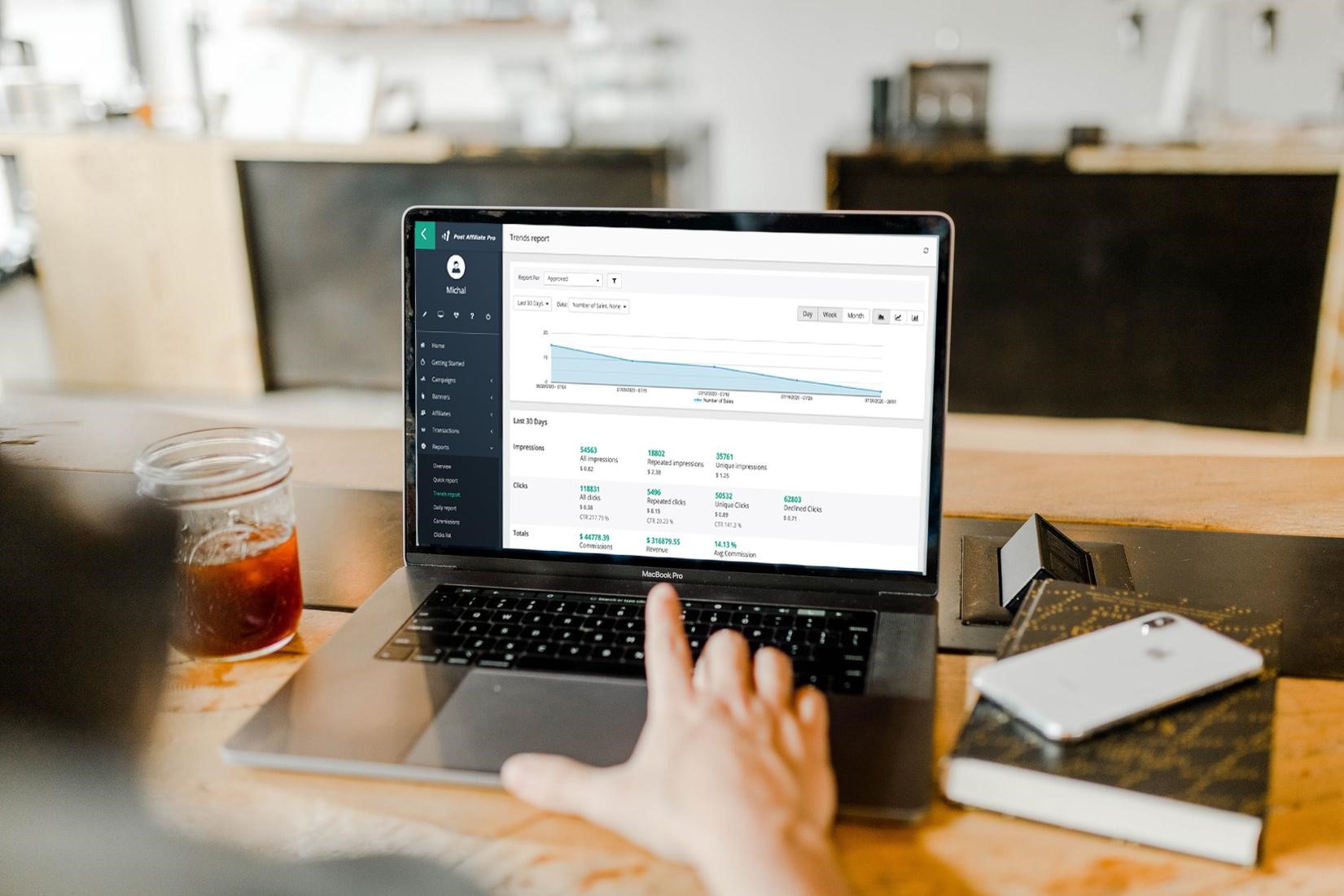
Affiliate marketing is a lucrative business for those who are eager to work from home and find success online. I’m sure you’ve seen blogs titled “How I Make 100k From Home” or something along those lines.
Although it’s possible to get filthy rich through affiliate marketing , it’s not easy. It takes hard work and dedication (just as in any profession). So, how can you get started and become successful?
Read on to find out! Our 6-step guide is the perfect resource for beginner affiliate marketers.
1. Find an Affiliate Niche That You’re Interested In

First, you need to find a niche that you’re passionate about. If you’re passionate about what you’re selling, it will be easier to transfer that enthusiasm into your promotions. There are tons of affiliate programs across different markets, so finding one that aligns with your interests shouldn’t be a problem.
Take some time to research which niches of those that you’re interested in are the least saturated or have the highest market potential. Consider golf, yoga, CBD, supplements, weight loss & fitness, essential oils, or cosmetics.
If you’re not sure which niches have the biggest potential to generate revenue, check out this article by Authority Hacker. It explains which niches and affiliate programs are the most lucrative for beginners.
2. Research Affiliate Programs & Apply to the Ones You Like Most
Once you’ve picked a niche that you want to focus on, it’s time to research affiliate programs. There are tons of articles out there that compare different programs based on commissions, search volume, keyword difficulty, and cookies.
Our suggestion is to apply to multiple affiliate programs, especially if they’re in the same niche. If you’re approved, you’ll be able to sell multiple products on your site, and gain commission from each program individually.
Moreover, not every affiliate program might accept you as an affiliate. Thus, it’s good to have back up options in case the programs you’re most interested in aren’t interested in you.
3. Create a User-Friendly Website That’s SEO Optimized
The next step is to create a stunning website. You should take your time when building it, to ensure it’s user and mobile-friendly, as well as SEO optimized. There are tons of tools that you can use for this, but our suggestion is to use a platform like Shift4Shop, as they usually have many free website themes you can choose from and come built-in with software that ensures your site is SEO ready.
When you start building your site, try to map out the buying process from start to finish. By doing this, you’ll see which steps are unnecessary and can be eliminated. You should always strive to keep the customer effort to a minimum. This means enabling guest checkout and asking customers only necessary questions during the checkout process.
Once you’ve built your site, it’s important to place your affiliate banners, links, and products on it. If you weren’t provided with professional promotional images, try to stylize and take high-quality photos of the products that you’re promoting so you can proudly upload them to your website, or even use them on social media.
4. Grow Your Social Media Presence

If you don’t have an established social media presence yet, it’s time to start building your brand. Our suggestion is to be active on as many social media platforms as possible because it ensures a larger reach among different audiences.
However, before you start building your social media presence, consider the products you’re promoting and the niche you’re in.
Ask yourself questions like, what platforms are my target audience present and active on? What kind of content do they like to consume? Finding out these answers will take some time. You’ll have to do some research, and perhaps even A/B test different marketing strategies.
If you’re not sure which platforms you should be present on, consider the following:
- YouTube: Great for educational videos, tutorials, and reaction videos.
- Facebook (Groups & Marketplace): Ideal for paid campaigns and promotions in closed professional groups.
- Instagram (Business Page & Shop): Ideal for millennial and Gen Z audiences.
- LinkedIn: A platform for business professionals, great for sharing eBooks, and articles containing unique research.
- Blog Posts: Blog posts on your website should be filled with optimized content.
- Reddit: Great for reaching segmented audiences in different types of subreddits.
- Medium: Great for posting educational content, similar to LinkedIn.
- Twitter: Can be used for hosting Twitter chats and interacting with your customer base.
- TikTok: A trending video platform that affiliates use to sell workout and diet plans, as well as electronics through short entertaining videos.
- Twitch: This platform lets you stream videos in real-time. It’s ideal for affiliates within the gaming and e-sports industries.
Certain audiences may be more inclined to watch YouTube videos, while others may be more influenced by Instagram posts or LinkedIn articles. The key is to get to know your audience.
One of the best ways to get to know them and their motivations is by creating buyer personas. Buyer personas are tools for audience segmentation that ensure that your marketing strategy aligns with your buyer’s motivations.
5. Create Content That Your Audience Thinks Is Valuable
Once you find out which platforms you should be present on, it’s time to start producing valuable content. This can range from interactive content such as YouTube videos to blog posts, eBooks, or even audiobooks.
Again, the key is to consider what kind of content your audience likes to consume. However, regardless of the content you make, the content should show your audience how the products/services you’re selling can bring them value.
For example, if you decide to promote CBD products, your content should explain how CBD supplements, ointments, or foods can improve your consumer’s quality of life. You could talk about CBD relieving pain, or reducing anxiety, or any other benefits that it has. It’s also important to address any concerns that your consumers might have about the product.
In the case of CBD, you should explain any side effects, it’s legality, and how one can use it properly (including appropriate dosage).
Establish yourself as an expert or a reliable source.
The best way to sell whatever you’re promoting through affiliate marketing is to establish yourself as a reliable source or as an expert in your niche.
As mentioned above, if you aim to sell CBD products, you should know the ins and outs of the benefits that CBD brings, as well as any possible side effects. You should also be able to talk about the products in a way that sparks the interest of your audience.
This can be achieved by speaking from experience, and genuinely showing your subscribers how daily CBD use has made a positive impact on your life, for example.
Optimize your content.

If you’re primarily posting blog posts and articles on your website to promote your affiliate products, you should make sure that the content you write is optimized for search engines. To do this effectively, you need to pick a focus keyword for each article that you write.
This keyword and its synonyms need to be repeated throughout the entire article, (even your title) ideally between 5-15 times. Your article should also have proper formatting including one H1 heading, and subheadings with H2 and H3 formats. You should also include both internal and external links inside your articles, as well as images with appropriate alt tags.
The last step is to write a meta description for your article that includes your focus keyword. By taking all these steps, your content will have a higher chance of showing up in people’s organic Google searches.
For example, if your article is about CBD and its effects on blood pressure, your focus keyword can be “CBD for high blood pressure.” If your article is optimized well and the keyword isn’t used often, the chances of your article showing up on Google’s first page are quite high.
Last but not least, it’s important to consider the length of your articles or blog posts. Generally, the longer the article (higher word count), the better the chance of ranking well on Google.
Consider paid ads.
Although this isn’t a very popular strategy among new affiliates, it’s worth considering. Most new affiliates don’t want to invest any money into promoting their affiliate links upfront, and thus prefer organic traffic.
However, when you’re starting, paid traffic can give you the boost you need to continue your affiliate marketing efforts organically. Our suggestion is to consider paid ads on Facebook, Instagram, and LinkedIn as they’re the most effective when it comes to paid promotion.
6. Add Support to Your Website to Convert Clicks to Sales
The last thing you should do is utilize a help desk software that streamlines and centralizes all the messages that you receive on every social channel you’re promoting your products on. In addition to that, you should also consider adding a live chat widget to your website.
If your potential customers see that you’re readily available to answer any questions they may have about the products you’re promoting, they’ll feel more comfortable purchasing them from you. This will build trust between you and your customers, building a pathway for repeat purchases and long-term relationships.
However, to build this trust, you need to ensure that you answer customer queries promptly and knowledgeably. Even though a help desk will help you centralize all customer queries, it’s up to you to answer all questions promptly.
Key Takeaways
Getting started with affiliate marketing can be fairly easy. However, before you do get started, you should take your time to research both affiliate niches and programs. Once you pick the niche and programs you like most, you will have to research your audience, the products you’re selling, and your competitors thoroughly.
By knowing what motivates your audiences to make purchases and knowing the ins and outs of your competitor’s products, you’ll know what your best-selling points are. Next, the selling points must be showcased through valuable content, on multiple channels.
Not every consumer or audience segment will be responsive to the same channels and the same content. Thus, it’s important to figure out what your audience is receptive to. The last step is to optimize your content and your website, so that it shows up in your potential buyer’s Google searches.
From there, it’s all about staying active and posting quality content on a daily or weekly basis. It’s also important to stay connected with your audience by replying to their questions and queries. As such, it might be beneficial to invest in a help desk software that centralizes and streamlines all communication channels into a single inbox.
By interacting with your consumers, you’ll be able to establish a level of trust, which can lead to more purchases in the future. In addition to that, positive relationships with your customers can contribute to your seller’s reputation. With positive reviews both online and through word-of-mouth, you’ll be able to attract more customers.
The bottom line? Affiliate marketing is all about knowing your product, optimizing content, and producing it regularly.





Leave a reply or comment below